You know your content matters. It’s time to prove it. | Webinar Recap

CMO or content creator, you already know that content matters like never before. Everyone wants to do more content, on more channels, and understand how that content is impacting their business.
We recently polled more than 800 content marketers and strategists for our Content Matters 2022 Report and found that a whopping 49% of them don’t actually know how their content is performing. No wonder so many content professionals struggle with getting executive buy-in for their programs.
In our webinar earlier this week, Parse.ly Co-Founder Sachin Kamdar took a hard look at these challenges content teams are facing, and broke down what it takes to deliver data-driven content that gets results.
He also shared new insights from the report, best practices for making content analytics easy, and examples of how organizations are aligning content strategies with business goals.
(Want to hear for yourself?)
Here are his highlights and key takeaways.
- Why content matters
- Content marketing continues to grow
- How can we do more with less?
- How do you get executive buy-in to prioritize content marketing?
- What should dictate the content you create?
- Key takeaways from Content Matters
Why content matters
Your content matters. And we all know that content is important to the way that we operate in this digital age. But I want to really get to the meat of that statement. Why does it matter?
Fundamentally, it matters because, as humans, we get moved by stories, by narratives. And the best way that we’re able to communicate stories online is through content—video content, text content, pictures.
What is important to our audience? The story itself, and the way we deliver that story.
The frustration that we’ve seen in this industry has to do with actually proving how important content is. Even though we know it’s accelerating, in terms of its overall importance and budget, how do we prove it?
First and foremost, it’s important to recognize that digital content isn’t just a thing you choose to have any more. It’s a requirement. The pandemic showed us that digital was the main avenue to intersect with your audience, your customers, and your prospects. If you don’t have a really good digital experience, you lose out to your competitors in this space.
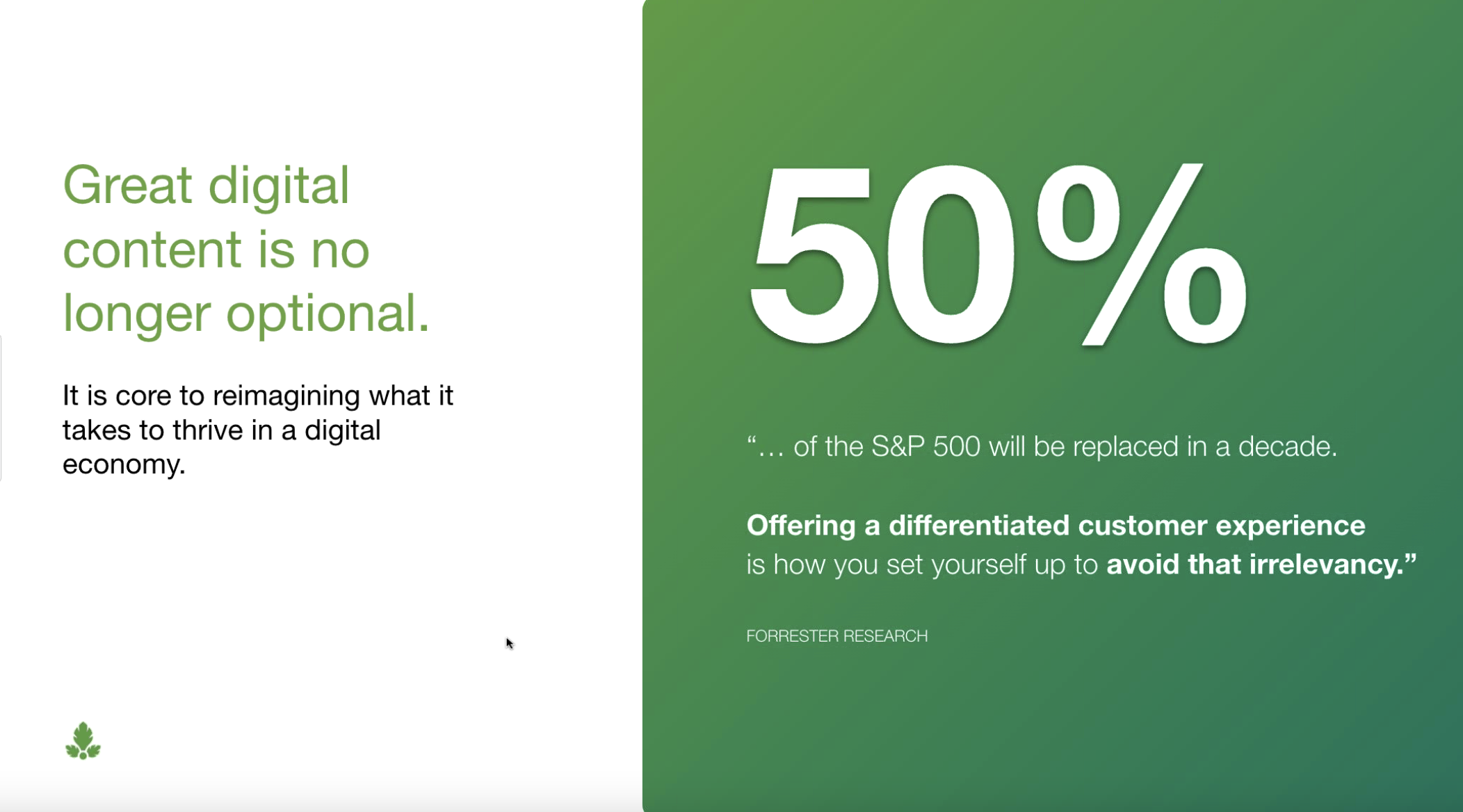
Fifty percent of the S&P 500 will be replaced in less than a decade. One of the critical pillars that is going to change who’s going to last in the S&P and who’s not is your ability to create compelling digital experiences. We all know that content is core to that. We have to be invested in content and do it in the right way.
Content marketing continues to grow
So, how are people doing this? We surveyed a bunch of content marketers to understand what the state of the industry is right now—where are they, how are they investing in this, what their challenges are, what their problems are.
We found that content marketing is really, really accelerating—66% said they created more content over the past year than they did the year before. And 50% said their content marketing budget grew over the past year. They’re creating more and they have more budget.
More than 40 percent said that they wanted to invest even more in content marketing.
There’s an overarching trend that we’re seeing where people are doubling down on content marketing. That’s really accelerating in all areas in terms of where content makes the most impact.
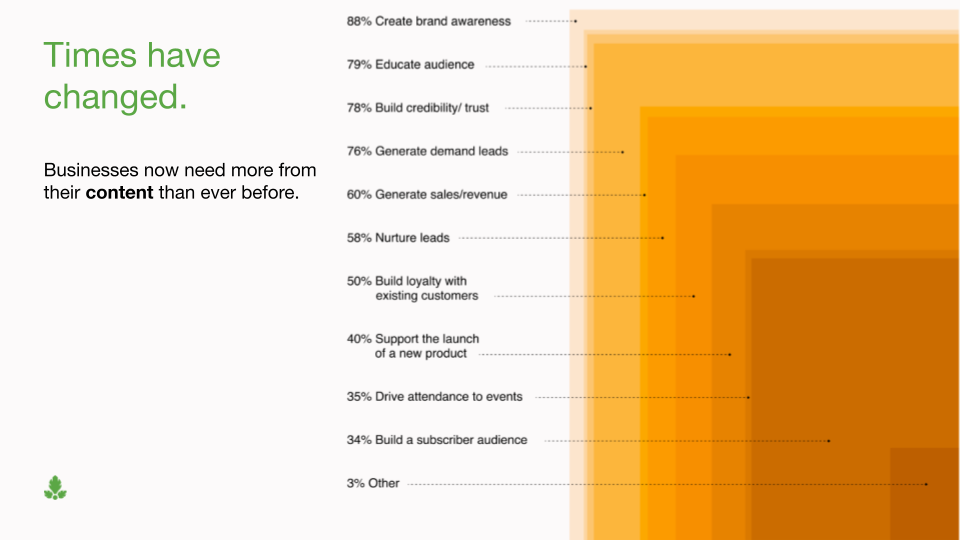
The number one area where content is making an impact for businesses is creating brand awareness. That’s where we see a lot of people getting results by educating their audience, and building credibility and trust.
Then, it’s almost like we skip over the engagement stage of the funnel and get right to ROI—generating leads, generating sales and revenue, nurturing leads. And then, below that, we see more of the engagement focus.
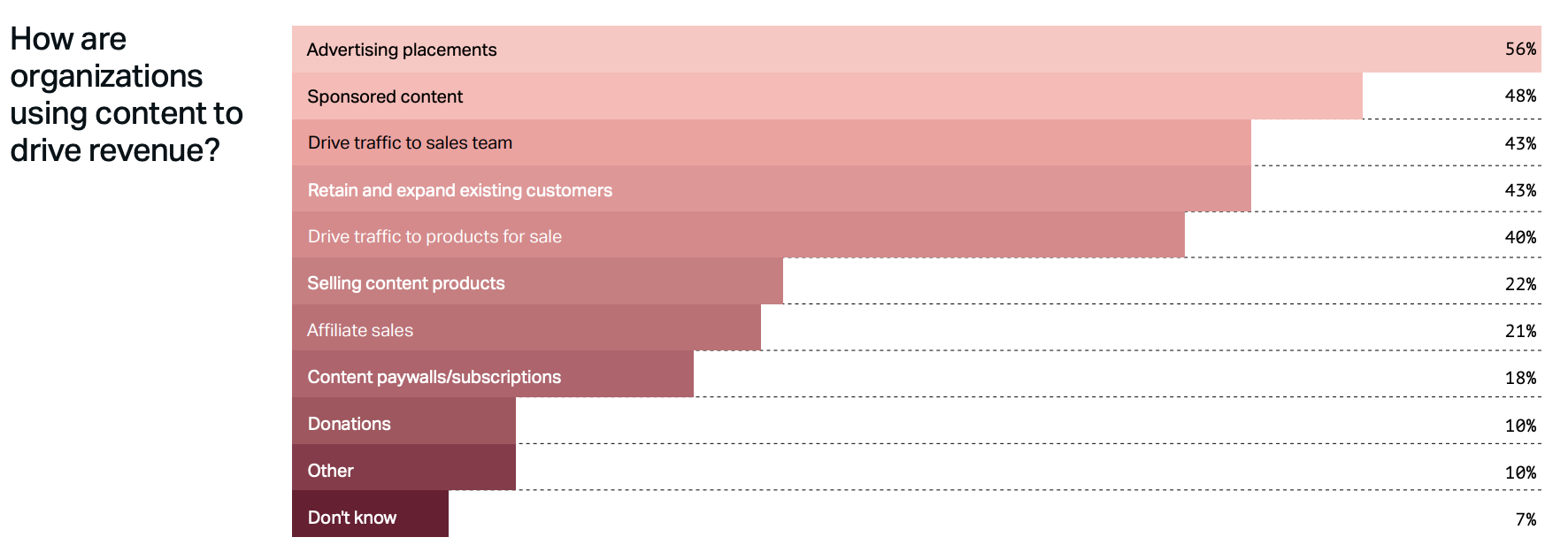
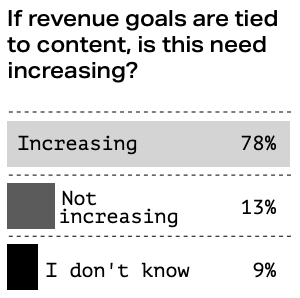
In terms of driving revenue, the top three things people are leveraging content for are advertising placements, sponsored content, and driving traffic to sales teams.
Now, what’s really important, is that 53% had no idea how their content was impacting revenue. Pair that with the stats about revenue goals being tied to content. If revenues goals are tied to content, is this need increasing? Of course it is.
Almost 80 percent said they need to tie content more closely to revenue goals. That’s an overarching trend we saw throughout this survey. The feedback, both anecdotal and quantitative, is that we need to understand how our content is helping drive our business goals and revenue. And we’re not there yet—53% couldn’t connect the two, but 78% know they need to.
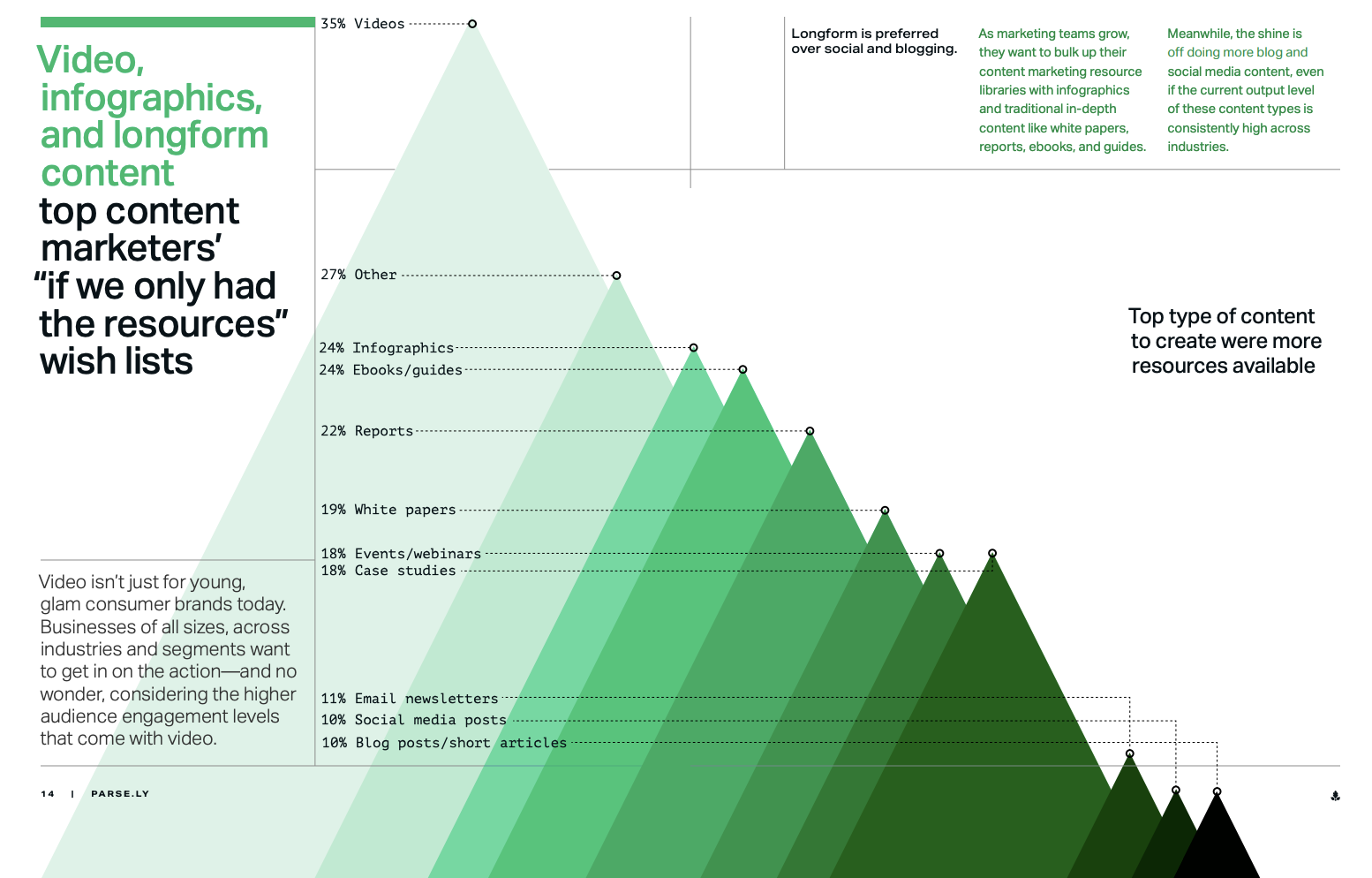
In terms of the type of content people want to create, it’s bit of everything. Respondents want to create more of all types of content, and 32% want to create twice as much as they do today. Forty-eight percent said they want to create a bit more, so that’s 80% of our respondents saying that they want more content.
A lot of people want to produce more videos and longform content. One takeaway from that is the costs of producing those is higher. So, it’s a question of taking the resources we have and applying them in those areas that are going to give us the most leverage. Though we might not have the ability to create video or longform at the scale that we want, what are things that we can do to help supplant that?
How can we do more with less?
This goes back to two things: how you’re understanding what your content is supposed to do for your business, and how you’re tracking this. Which authors are creating content with the best results? Which topics generate the best results? What’s working for competitors? And how will you leverage all this to create more with less?
Even if we hire twice as many people to produce content for us tomorrow, we know that there’s going to be a lag in seeing results. Will it happen in the next quarter, six months or year?
I encourage you not to think about what you’re going to do in the next 12 months, but to think about what you’ve done in the past 12 you can leverage and double down on to get more out of what you created.
For example, one of the things that I think often gets overlooked is the ability to create evergreen content that has a long life cycle. Often, it’s easy to just hop on the latest trends, while ignoring what’s going to have lifespans of days, weeks, even months. Evergreen content keeps generating results for your business, as opposed to content that has only a 24- to 48-hour life cycle.
That’s one way to do it. Again, you have to understand how that’s tying into the business overall. And you have to understand what you have enabled to achieve this.
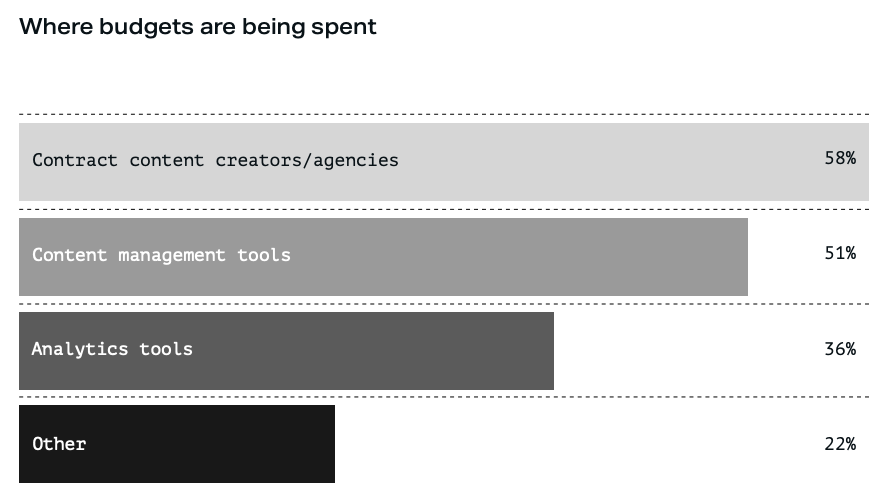
Fifty-eight percent said they’re spending their budget on content creators and agencies, as opposed to technology like content management and analytics tools.
As we’re ramping up this content marketing spend—hiring more people, creating more content—I assume the secondary effect would be spending more on technology to make sure that we’re getting more out of less. But that’s actually not what we saw.
This tells us we’re still in the early days of getting results out of our content. As we get into the coming quarters and years, you’ll start to see investments in technology equal or even beat what we’re seeing in terms of investments in content creators and agencies.
How do you get executive buy-in to prioritize content marketing?
How do you get your boss to get excited about what you’re doing? How do you get your boss or whomever is approving the budget to prioritize content over other potential marketing strategies?
This goes back to what management cares about. We all know content is important, but why is it so hard to justify it? We know management has been obsessed with ROI as a crucial barometer of success. But with so few marketers able to attribute ROI to their content plan, it’s no surprise that it’s hard to get executive buy-in.
You need to be able to say, “Hey, the content program that I launched is generating X amount of conversions or X amount of leads.” That’s the stuff that executives want to see.
It really is about how you’re taking the content that you have, aligning it with those business goals, and then providing the data insights back to management. So they can feel comfortable saying, “Hey, let’s double your budget. Let’s triple your budget. Let’s quadruple your budget and really start to get serious about content.”
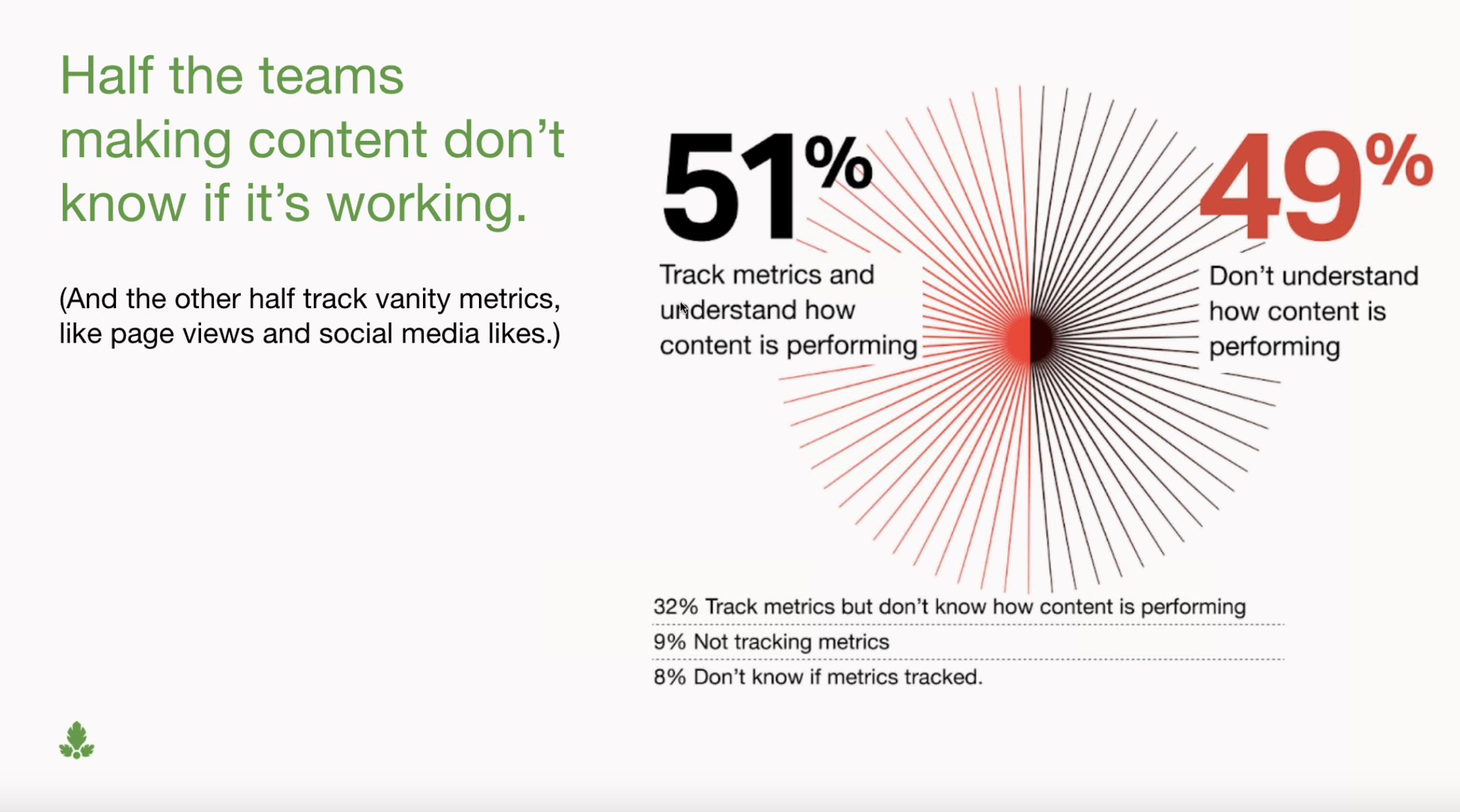
This is really, really interesting to me. Half the teams said they had no idea what was working. Forty-nine percent didn’t understand how their content was performing, 9% weren’t tracking metrics at all, 8% didn’t even know if they were tracking metrics. And 32% said, “No, we’re tracking metrics but we don’t know if those metrics are actually telling us what’s working.”
Pair this with knowing executives want content ROI, and all of a sudden, all this starts to click. We have to be able to track the right things to generate the right type of insights that are then going to compel the right people in our organizations to invest more in what we’re doing.
What should dictate the content you create?
In our report, we cite that 69% of content strategy decisions come from other teams not from you, the content experts, nor the data that’s telling you what’s working.
Of course, we have to make sure we listen to others in organization but we can’t act in silos and ignore the data. We have to go with our own experience as experts here, to decide what is going to work in terms of content. This again speaks to the fact that content marketing is an immature discipline now.
Imagine if I asked the same question, “Where do strategy decisions come from?” and didn’t say in terms of content but rather in terms of Google search, keyword ads—”Where are your requests coming from to create paid ads?” —and 69% said they’re coming from other teams.
We’d be like, “Why?”
We have to understand what’s working, we have to consider competitors. It would be crazy if 69% of our decision making was coming from other people, telling us what to do.
From an ad perspective, we have all the data and insights to understand what’s working. We have all kinds of sophistication and science that comes into play in making those decisions.
We really need to try and elevate the content side of things. The rest of the people trying to jockey for the attention of your audience aren’t in that 69%.
Key takeaways from Content Matters
- Content marketing is hot.
- If you are investing in digital experiences, which should be every company in the world, you need to have content, because content drives growth.
- Companies want more content. People are producing more and getting more budget.
- But companies aren’t always taking a sophisticated approach. They’re just throwing agencies and content creators at it.
How Parse.ly can help
We can help you take a more sophisticated approach, actually understand how your content is performing, and really prove the value of your content to get that executive buy-in.
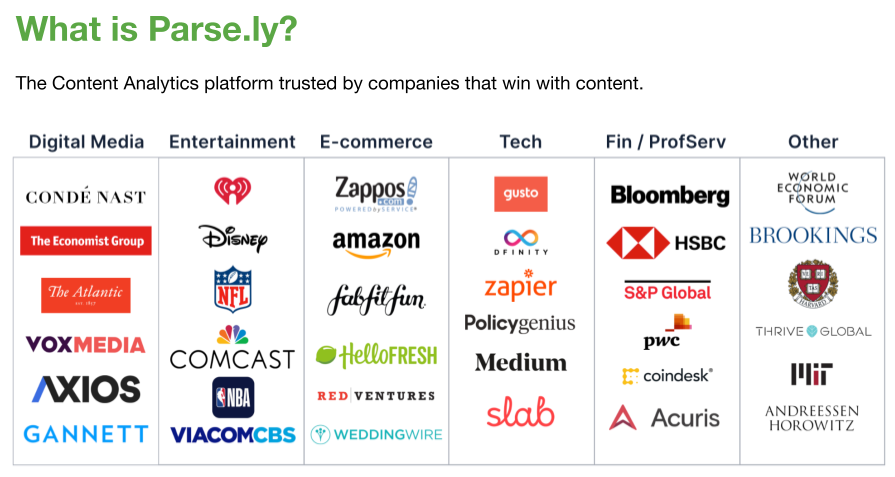
We have done this in so many different industries, for so many different organizations. We help them connect content metrics to business results so they can justify investment.
Companies leveraging Parsley know why their content exists and they use it to achieve their goals. It’s not enough to say, “Hey, we need content.” You need to know what your content is trying to achieve and be very clear about that both internally with your department or group and externally to your executives and stakeholders.
Are we trying to drive top- of-funnel awareness? Are we trying to generate engagement through newsletters, webinars, sign-ups? Or are we trying to use content to generate purchases, subscriptions, add-to-carts, or demo requests?
If you can answer these questions and you understand what your content is going to achieve, you’re 50% beyond where a lot of companies that we start working with are right now.

The first thing you need to do is this: understand why your content is there and what it’s trying to achieve. Then, you need to recognize that the systems that you have—if they don’t include Parse.ly—are broken.
They weren’t built to understand content or the customer journey. They focus on vanity metrics and landing pages as opposed to the full journey. And frankly, they’re unpleasant and hard to use.
That’s really the opposite of what we think about with Parse.ly. We walk that fine line of creating comprehensive, complex analytics, but do in a way that makes it accessible and allows you to democratize its use across your organization.
The three reasons content and marketing teams use Parse.ly are:
- We help you align your content strategy with business goals.
- We help you understand the performance of your content.
- We help you prove out that ROI.
It’s not about analysts using analytics. It’s about the rest of the organization using data and analytics to drive their results.
Note: Check out the full webinar to learn more about the challenges content marketers are facing, our Content Matters 2022 Report, and how Parse.ly is helping teams become more sophisticated and evolved in their content strategies.